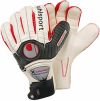
|
"Outstanding keeper instruction. This is a must for goalkeepers and coaches." — Ottawa Internationals S.C. web site, Ottawa, Canada |

|

|
|
|
Top |
Next: The
Laws
|
He used to dress in black, like the referee. Now the referee doesn't have to dress like a crow and the goalkeeper can populate his solitude with colorful fantasies.
-- Eduardo Galeano, Soccer in Sun and Shadow
| CONTENTS |
|---|
|
Gloves - What to Look For Gloves - Care Jerseys Shorts and Pants Hats What Not to Wear Related Blog Entries |
The special demands of goalkeeping call for special equipment. Exactly what a keeper uses is personal preference, but here are some notes on goalkeeping equipment. (Buy your gear via the links on this page and help support this site!)
Gloves
Goalkeeping gloves are designed to protect the goalkeeper's hands as well as provide a better grip on the soccer ball. They range in price from $10 to over ten times that! The gloves a keeper buys will depend on budget and needs, but here are some things to look for when purchasing gloves.
- Grip. How well does the glove surface (usually latex foam)
stick to the ball? In general more smooth foam grips better than dimpled
foam.
 I don't recommend
gloves with rubber "ping-pong paddle" grip or
rubberized grids - they just don't grip well enough. I also recommend gloves
where the entire palm surface is foam, not just a few spots here and
there. More expensive gloves have specialized foams (and better
marketing!), but that doesn't necessarily mean they always grip better.
I don't recommend
gloves with rubber "ping-pong paddle" grip or
rubberized grids - they just don't grip well enough. I also recommend gloves
where the entire palm surface is foam, not just a few spots here and
there. More expensive gloves have specialized foams (and better
marketing!), but that doesn't necessarily mean they always grip better.
- Durability. It would be nice if those expensive gloves lasted for a long time. Unfortunately, great grip sometimes comes at the expense of durability. Thicker foam will usually last longer, since the grip goes throughout the foam itself and is not just at the surface. Some soccer gear catalogs ( Eurosport paper catalog and KeeperStop.com) have durability as well as grip ratings for the gloves they sell. Durability applies to more than just the foam, too. Poorly made gloves can start coming apart at the seams before the grip is worn out.
- Cushioning. Gloves provide cushioning to take the sting off a hard hit ball. Thicker foam and glove material helps this; just make sure it's not so thick it hinders the grip.
- Wrist Support. Decent gloves will provide some support for
the wrist which can help prevent injury on very hard shots. Look for a
wide wrist strap that can be tightened securely.

- Comfort. What glove feels comfortable will vary from keeper to keeper. Some gloves are made with vents or breathable materials to prevent sweaty hands.
- Fit. While goalkeeper gloves should naturally be a bit large-looking on the hands, the exact fit, tight or loose, is up to personal preference. Some keepers like their gloves snug, others like them a bit larger. Many keepers who like close-fitting gloves prefer a negative-cut glove (finger seams are sewn on the inside), which are designed for a more snug fit. On the other hand (so to speak), resist the temptation to buy gloves that are too large, especially for young, growing keepers. The gloves should not be so big that the hand moves around inside them or the gloves twist or bend around the hand.
- Other features. Manufacturers have come up with all kinds of ways to get you to spend more on goalkeeping gloves. Finger protection is one of the most popular - the glove's fingers have plastic inserts that allow the fingers to flex forward normally but not bend backwards. The intent is to prevent finger injury, at the expense of some feel and flexibility. While they may help against certain types of injuries and provide a feeling of security, they are not a cure-all for injury problems or a substitue for developing strong hands. Other gloves have special foams for certain conditions, differently sewn seams, etc. The choice of any of these should be dictated by keeper preference and wallet size.
Glove Care
Once you've gone out and spent all that money on a pair of gloves, you want them to last as long as possible. For gloves, an ounce of prevention is worth a pound of cure. Here are some basic tips for prolonging the life of keeper gloves:
-
 The biggest thing a keeper can do to make their gloves last longer is to
use proper technique! Catch the ball and use it to cushion a fall instead
of slapping it away and falling on the hands, and don't use hands to get up
if possible. Practice, practice, practice.
The biggest thing a keeper can do to make their gloves last longer is to
use proper technique! Catch the ball and use it to cushion a fall instead
of slapping it away and falling on the hands, and don't use hands to get up
if possible. Practice, practice, practice.
- Keep two sets of gloves, one for practice and one for games only. When my match gloves start to lose it, I relegate them to the practice pile. Only use the $100 gloves for games.
-
 Wash the gloves after every use. This has two benefits - it
removes dirt and grime from the latex, and it keeps them from
smelling! (The latter is a major benefit when gloves are being shared.)
Hand wash them in mild dish soap (I have never had a
problem with this damaging the foam - however, don't use dishwasher
detergent) and rinse them thoroughly with clean water. Let them
air dry out of the sun.
Wash the gloves after every use. This has two benefits - it
removes dirt and grime from the latex, and it keeps them from
smelling! (The latter is a major benefit when gloves are being shared.)
Hand wash them in mild dish soap (I have never had a
problem with this damaging the foam - however, don't use dishwasher
detergent) and rinse them thoroughly with clean water. Let them
air dry out of the sun.
- Store them in a plastic bag in a cool, dry place (not the trunk of the car). Make sure the gloves are dry first so they won't mildew. The plastic bag will keep the foam from losing its resiliency and tackiness.
- Most latex foam gloves will grip best if slightly dampened before use. The keeper should have a water bottle in goal not only for drinking, but for moistening gloves on dry days. A little water can make old gloves usable for just a little while longer.
For more information and tips on glove care, see this article on Taking care of your goalkeeper gloves, courtesy of KeeperStop.com.
A final note on gloves:
![]() even expensive, sticky gloves are no substitute for proper
catching technique.
A good goalkeeper should be able to perform well without any gloves
at all; gloves merely add a measure of safety and comfort.
even expensive, sticky gloves are no substitute for proper
catching technique.
A good goalkeeper should be able to perform well without any gloves
at all; gloves merely add a measure of safety and comfort.
Goalkeeping Jerseys

Goalkeeping jerseys are traditionally long-sleeved to protect the elbows against the occasional scrape on a dive (you'll note that any elbow padding on a jersey is not significantly thick). A number of goalkeepers, though, favor short sleeves.
The only stipulation in the Laws is that the goalkeeper wear "colours
which distinguish him from the other players, the referee and the assistant
referees". So the
![]() goalkeeper should have at least two jerseys that differ from their
team's uniform, and possibly a third to avoid conflict
with referees. (The official referee uniform color is yellow as of this
writing, so that may be a good color to avoid for goalkeeping jerseys if
you're buying new ones.)
goalkeeper should have at least two jerseys that differ from their
team's uniform, and possibly a third to avoid conflict
with referees. (The official referee uniform color is yellow as of this
writing, so that may be a good color to avoid for goalkeeping jerseys if
you're buying new ones.)
Any other goalkeeping jersey feature, like sticky dots on the chest, is mere marketing. You can't catch a soccer ball with your chest!
Goalkeeping Shorts and Pants

Goalkeeping shorts and pants are traditionally padded at the hip to protect the keeper on dives. Full pants are particularly useful if the soccer field has little grass or lots of rocks. Special shorts or pants aren't a necessity although some keepers prefer them.
If the keeper plays wearing shorts, I would
![]() recommend a pair of compression or bicycling-type undershorts
(aka "sliders"—which must be the same color as the main
short, according to the Laws). These will not hike up on a slide,
helping to prevent "strawberry" scrapes on the hip and upper leg.
recommend a pair of compression or bicycling-type undershorts
(aka "sliders"—which must be the same color as the main
short, according to the Laws). These will not hike up on a slide,
helping to prevent "strawberry" scrapes on the hip and upper leg.
Additionally, it might be a good idea for a keeper to
![]() have an inexpensive pair of pants or sweats in their bag for protection on
days when the
training topic will be breakaways and there will be lots of sliding.
have an inexpensive pair of pants or sweats in their bag for protection on
days when the
training topic will be breakaways and there will be lots of sliding.
Hats
If the sun is low at game time, goalkeepers will often be allowed by a referee to wear a hat to shade their eyes. The hat should be soft-billed with a bill that is not too long. I like to use a bicycling cap - the bill is short, it can be easily flipped up out of the way, and they are usually elastic-lined so they will stay securely on the head.
Make sure you clear any non-standard equipment like a hat with the center referee before the game.
Equipment That Should Not Be Part of a Keeper's Uniform
I often see goalkeepers wearing a couple of items that they probably should not be using.- Knee Pads.
 I believe goalkeepers should never wear
knee pads. You never see the pros wear them, and you will not find
a single technique on my pages that
requires a keeper to land on their knees (although a few training
progressions will have steps where they start from their knees).
I believe goalkeepers should never wear
knee pads. You never see the pros wear them, and you will not find
a single technique on my pages that
requires a keeper to land on their knees (although a few training
progressions will have steps where they start from their knees).
 If your keeper regularly skins their knees, go analyze their play to
find out why they are doing so and fix their technique! Particularly
watch dives and ground or rolling ball pick-ups, as these are techniques
that often result in bloody knees when done incorrectly.
If your keeper regularly skins their knees, go analyze their play to
find out why they are doing so and fix their technique! Particularly
watch dives and ground or rolling ball pick-ups, as these are techniques
that often result in bloody knees when done incorrectly.
- Elbow Pads. Although not as bad as knee pads, elbow pads also should not be used for similar reasons. Landing on the elbows can certainly be dangerous, but rather than putting elbow pads there, the keeper's technique should be fixed so they are not falling on their elbows in the first place. A long-sleeve jersey should be enough to protect against the occasional elbow scrape.
|
|
Top |
Next: The Laws
|